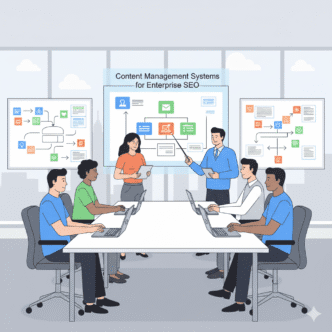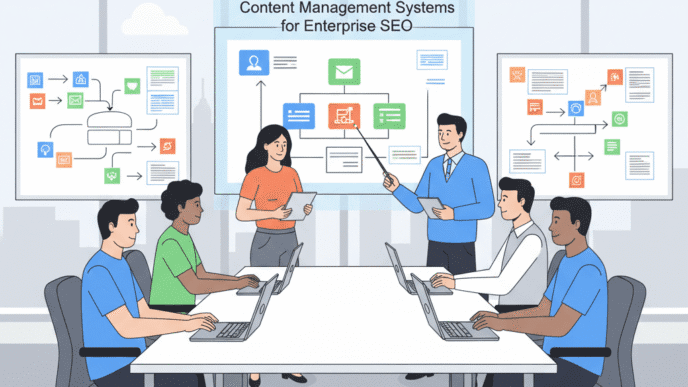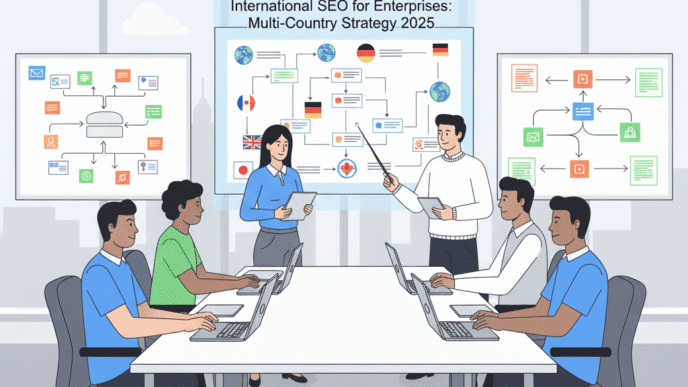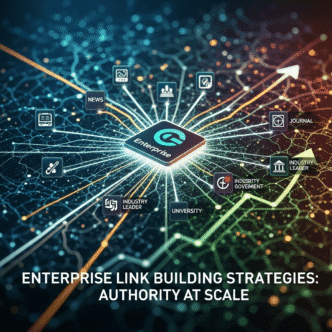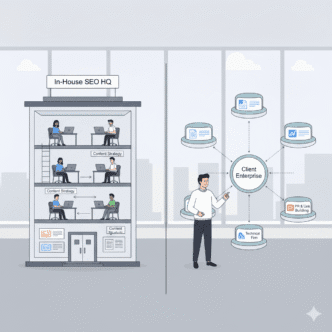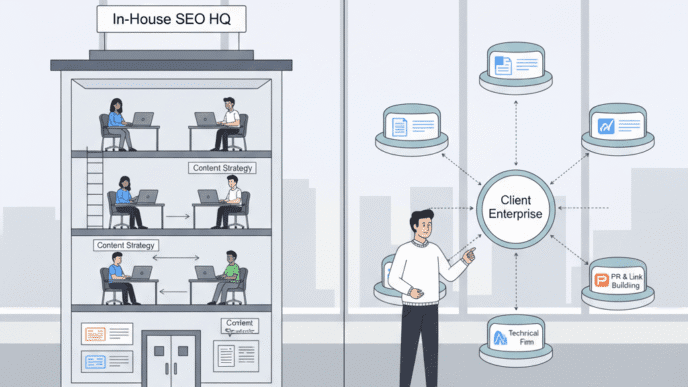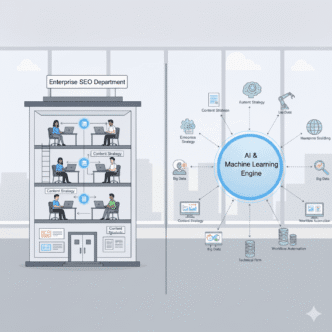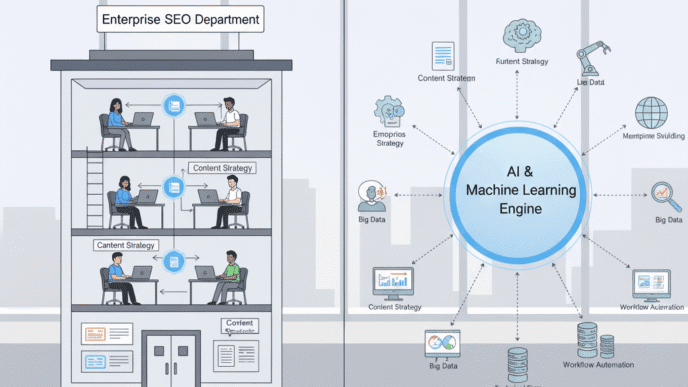Picture this: You’re the SEO director at a Fortune 500 company, and your boss just asked why organic traffic dropped 35% last month. You scramble through Google Analytics, only to discover that a “minor” site update accidentally noindexed 50,000 product pages.
Welcome to the high-stakes world of enterprise technical SEO audit nightmares.
Here’s the brutal truth: When you’re managing websites with hundreds of thousands (or millions) of pages, a single technical error can cost your company more money in one day than most small businesses make in a year. That misconfigured robots.txt file? It just blocked Google from crawling your entire e-commerce catalog.
An enterprise technical SEO audit isn’t just a glorified checklist—it’s your insurance policy against catastrophic ranking losses. It’s the difference between proactive optimization and panic-driven firefighting at 2 AM when executives start asking uncomfortable questions.
In this comprehensive guide, I’ll walk you through exactly how to conduct technical SEO audit for enterprise website operations, which tools actually deliver at scale, and the critical mistakes that tank rankings faster than you can say “canonical tag disaster.”
Let’s dive in before your next site migration becomes your career-limiting move.
Table of Contents
ToggleWhat Is an Enterprise Technical SEO Audit and Why Does It Matter?
An enterprise technical SEO audit is a comprehensive analysis of your website’s technical infrastructure, examining everything from crawlability and indexation to site speed and structured data implementation across massive page volumes.
Think of it as a full-body MRI for your website—except instead of checking for health issues in a human body, you’re diagnosing technical problems that prevent search engines from properly crawling, indexing, and ranking your content.
For large-scale website audit projects, you’re not just looking at a few hundred pages. You’re analyzing hundreds of thousands (sometimes millions) of URLs, multiple subdomains, international versions, and complex site architectures that would make a small business owner’s head spin.
According to a 2024 study by Backlinko, technical SEO issues directly impact 53% of all ranking fluctuations for enterprise websites. That’s more than half of your organic visibility controlled by technical factors most stakeholders don’t even understand.
Pro Tip: The biggest difference between enterprise and small-site audits isn’t just scale—it’s that enterprise issues compound exponentially. A redirect chain affecting 10 pages on a small site is annoying. The same issue affecting 100,000 pages can crash your crawl budget and tank rankings site-wide.
How Does Enterprise Technical SEO Differ from Regular Technical SEO?
Regular technical SEO and enterprise SEO operate in completely different universes. Let me break down the key differences that make enterprise audits uniquely challenging.
Scale and Complexity
Small site technical SEO might involve manually checking 200 pages. Enterprise site architecture optimization requires automated systems analyzing 2 million pages while you sleep. The tools, processes, and expertise required are fundamentally different.
You’re dealing with multiple CMS platforms, legacy systems that haven’t been updated since 2015, and technical debt that makes developers cry during planning meetings.
Stakeholder Coordination Challenges
At the enterprise level, implementing a simple technical fix requires navigating complex organizational structures. You’ll need buy-in from IT, development teams, legal (yes, really), compliance departments, and executives who think “canonical tags” are something you sing in church.
According to research from BrightEdge, 68% of enterprise SEO professionals cite stakeholder alignment as their biggest technical implementation challenge—bigger than the technical complexity itself.
Resource Requirements
Enterprise technical SEO audit projects demand serious investment. You can’t run these audits with Screaming Frog’s free version and hope for the best. We’re talking enterprise-grade tools with price tags starting at $10K-$50K annually, plus the expertise to interpret massive datasets.
Risk Management
When a small website goes down, it’s bad. When an enterprise website crashes, it makes the news. When your technical SEO at scale audit reveals that migrating to a new platform could temporarily impact 40% of organic traffic, you better have a comprehensive risk mitigation plan.
One wrong move during a technical audit implementation can cost millions in lost revenue before anyone notices something’s wrong.
What Are the Essential Components of an Enterprise Technical SEO Audit?
Let’s break down the critical elements you absolutely cannot skip when conducting a comprehensive large-scale website audit.
1. Crawlability and Indexation Analysis
This is where most enterprise nightmares begin. You need to understand how search engines crawl your massive site and which pages actually make it into Google’s index.
Key areas to audit:
- Robots.txt configuration (have you accidentally blocked important sections?)
- XML sitemap structure and accuracy across all site sections
- Crawl budget optimization for maximum efficiency
- NoIndex, NoFollow, and meta robots tag implementation
- URL parameter handling and faceted navigation issues
A common enterprise mistake: Having 2 million pages published but only 800,000 indexed. Where did the other 1.2 million pages go? Usually, they’re lost in technical limbo—blocked by robots.txt, buried under redirect chains, or tangled in duplicate content chaos.
Pro Tip: Use Google Search Console’s Index Coverage report combined with server log file analysis to identify discrepancies between pages you want indexed and pages Google actually crawls. The gap reveals your biggest opportunities.
2. Site Architecture and Internal Linking Structure
Enterprise site architecture optimization can make or break your organic performance. A poorly structured site forces users and search engines through unnecessary complexity.
Critical audit points:
- Information architecture depth (can users reach any page within 3-4 clicks?)
- Internal linking patterns and authority flow
- Orphan pages with zero internal links
- Category and subcategory optimization
- Breadcrumb implementation across page templates
According to Moz, proper internal linking structure can improve rankings by 40-50% for enterprise sites by efficiently distributing PageRank across important pages.
3. Core Web Vitals and Page Speed Performance
Google’s Core Web Vitals aren’t suggestions—they’re ranking factors. For enterprise websites, optimizing performance across thousands of page templates presents unique challenges.
What to measure:
- Largest Contentful Paint (LCP) – Should be under 2.5 seconds
- First Input Delay (FID) – Should be under 100 milliseconds
- Cumulative Layout Shift (CLS) – Should be under 0.1
- Time to First Byte (TTFB) across different page types
- Mobile performance separately from desktop
Real-world impact: A 2024 case study from Portent found that B2B sites making less than $100K/year convert at 3.5%, while sites earning over $5M/year convert at just 2.5%—largely due to slower page speeds as site complexity increases.
4. Mobile Optimization and Responsive Design
With Google’s mobile-first indexing, your mobile site IS your site. Period. Your enterprise technical SEO audit must prioritize mobile experience across all device types.
Mobile audit essentials:
- Responsive design implementation across all templates
- Mobile usability errors in Search Console
- Touch element sizing and tap target spacing
- Mobile-specific page speed issues
- Viewport configuration and scaling
5. Structured Data and Schema Markup
Structured data implementation helps search engines understand your content better and can unlock rich results that dominate SERPs.
Schema types for enterprise sites:
- Organization schema for brand entity recognition
- Product schema for e-commerce pages
- Article schema for content hubs
- FAQ schema for high-visibility snippets
- BreadcrumbList schema for navigation clarity
- Review schema for trust signals
According to research by Search Engine Land, pages with structured data rank an average of 4 positions higher than pages without markup for commercial queries.
6. HTTPS and Security Implementation
Security isn’t optional—it’s a ranking signal and a trust factor. Your large-scale website audit must verify proper HTTPS implementation across every single page.
Security audit checklist:
- SSL certificate validity and configuration
- Mixed content warnings (HTTP resources on HTTPS pages)
- Redirect chains from HTTP to HTTPS
- Security headers (HSTS, CSP, X-Frame-Options)
- Third-party script security vulnerabilities
7. International SEO and Hreflang Configuration
For global enterprises, international SEO auditing prevents your French site from showing up in German search results (and vice versa).
Hreflang audit priorities:
- Proper hreflang tag implementation and syntax
- Bidirectional linking between language versions
- Self-referential tags on every page
- Canonical URL alignment with hreflang
- Language and region code accuracy
A 2024 study by Aleyda Solis found that 78% of enterprise international sites have critical hreflang errors costing them 30-50% of potential international organic traffic.
8. Duplicate Content and Canonicalization
Duplicate content is enterprise SEO’s silent killer. With millions of pages, you’ll inevitably create variations that compete against each other.
What to identify:
- URL parameter handling for filters and sorting
- WWW vs non-WWW canonicalization
- Trailing slash inconsistencies
- Pagination and faceted navigation issues
- Print-friendly or mobile-specific page versions
- Canonical tag implementation across all page types
What Tools Do You Need for Enterprise Technical SEO Audits?
You can’t conduct a proper enterprise technical SEO audit with free tools and spreadsheets. You need industrial-strength software designed to handle massive data volumes.
Best Enterprise Technical SEO Audit Tools for Large Organizations
Let me break down the tools that actually work at enterprise scale, based on managing audits for Fortune 500 companies.
| Tool | Best For | Enterprise Features | Pricing | Limitations |
|---|---|---|---|---|
| Screaming Frog SEO Spider | Comprehensive crawling | Unlimited crawls, custom extraction, API integration | $259/year | Memory-intensive for 1M+ pages |
| Botify | Log file analysis, massive sites | Real-time monitoring, 100M+ page support, machine learning insights | $50K+/year | Premium pricing, steep learning curve |
| DeepCrawl (Lumar) | Continuous monitoring | Scheduled crawls, automation, custom alerts | $30K-$100K/year | Complex setup required |
| Sitebulb | Visual reporting | Beautiful reports, desktop software, excellent for audits | $50/month | Limited to 100K URLs per crawl |
| OnCrawl | Technical SEO at scale | Log file analysis, data studio integration | $25K+/year | Less intuitive interface |
| Google Search Console | Index coverage, performance data | FREE, direct Google data, mobile usability | Free | Limited historical data, sampling issues |
| Ahrefs Site Audit | All-in-one platform | 10M URL crawling, automated monitoring | $399-$999/month | Not specialized for enterprise |
Pro Tip: Don’t rely on a single tool. The best enterprise technical SEO audit approach combines Screaming Frog for deep crawling, Botify or DeepCrawl for continuous monitoring, and Google Search Console for ground truth data. Each tool reveals different insights.
Specialized Tools for Specific Enterprise Needs
Beyond general crawlers, you’ll need specialized tools for specific technical audit areas:
Page Speed and Performance:
- GTmetrix for detailed performance breakdowns
- WebPageTest for multi-location testing
- Chrome DevTools for real-time debugging
- PageSpeed Insights for Core Web Vitals data
Log File Analysis:
- Botify Analytics (premium solution)
- Screaming Frog Log File Analyser
- Splunk (for enterprises with advanced analytics teams)
Schema and Structured Data:
- Google’s Rich Results Test for validation
- Schema.org validator for markup verification
- Merkle’s Schema Markup Generator for creation
How to Conduct a Technical SEO Audit for Enterprise Website Operations
Now let’s walk through the actual process of running a comprehensive enterprise technical SEO audit that identifies high-impact issues without drowning your team in low-priority minutiae.
Phase 1: Pre-Audit Preparation and Goal Setting (Week 1)
Before you crawl a single URL, you need clarity on objectives and scope. Otherwise, you’ll waste weeks analyzing issues that don’t move the needle.
Critical preparation steps:
Define clear audit objectives – What are you trying to achieve? Improve rankings? Prepare for a migration? Diagnose traffic loss?
Identify key stakeholders – Who needs to be involved from development, IT, content, and executive teams?
Document current baseline metrics – Capture current organic traffic, rankings, index coverage, and Core Web Vitals scores
Determine audit scope – Which subdomains, international versions, and page types will you include?
Set up proper tool access – Ensure you have admin access to Search Console, Analytics, and enterprise SEO platforms
Pro Tip: Create a stakeholder communication plan before starting your audit. Technical SEO findings mean nothing if you can’t effectively communicate their business impact to decision-makers who approve implementation budgets.
Phase 2: Comprehensive Site Crawling and Data Collection (Week 2-3)
This is where the heavy lifting happens. You’ll be collecting massive amounts of data that reveal your site’s technical health.
Crawling best practices for enterprise sites:
Start with a full Screaming Frog crawl – Set appropriate speed limits (2-5 URLs/second) to avoid overwhelming servers
Crawl different bot user-agents – Test how Googlebot and other search engines see your site versus regular users
Export log file data – Request 90 days of server logs from your IT team for log file analysis
Run Google Search Console exports – Download index coverage, Core Web Vitals, and mobile usability reports
Benchmark page speed across templates – Test at least 100 pages from each major template type
Document current security configuration – Run SSL and security header tests
According to Search Engine Journal, the data collection phase should consume 40-50% of your total audit time. Rushing this step leads to incomplete findings and missed critical issues.
Phase 3: Data Analysis and Issue Prioritization (Week 3-4)
Raw data means nothing without proper analysis. This phase separates amateur audits from professional enterprise technical SEO audit work.
Analysis framework:
Critical Issues (Fix Immediately):
- Pages blocked from crawling that should be indexed
- Widespread noindex tag errors
- Broken internal links on high-traffic pages
- Security certificate issues
- Mobile usability errors affecting conversions
High-Priority Issues (Fix Within 30 Days):
- Core Web Vitals failures across page templates
- Duplicate content from canonicalization errors
- Inefficient site architecture creating crawl waste
- Hreflang implementation errors
- Structured data markup missing or incorrect
Medium-Priority Issues (Fix Within 90 Days):
- Redirect chain cleanup
- Image optimization for page speed
- URL structure improvements
- Internal linking optimization
- Non-critical schema enhancements
Low-Priority Issues (Ongoing Optimization):
- Minor metadata improvements
- Image alt text additions
- Breadcrumb enhancements
- Social meta tag optimization
Phase 4: Creating Actionable Audit Reports (Week 4-5)
Your audit findings are worthless if stakeholders don’t understand them or can’t act on them. Your report must translate technical jargon into business impact.
Effective enterprise audit report structure:
- Executive Summary – High-level findings with revenue impact estimates
- Critical Issues Dashboard – Visual representation of immediate threats
- Detailed Technical Findings – Organized by category with examples
- Implementation Roadmap – Phased approach with resource requirements
- Success Metrics – How you’ll measure improvement post-implementation
- Risk Analysis – Potential issues with proposed fixes
Pro Tip: For every technical issue you identify, answer three questions in your report: (1) What’s broken? (2) Why does it matter to business goals? (3) How much will it cost to fix versus leaving it broken? Executives approve budgets based on ROI, not technical perfection.
Phase 5: Implementation and Validation (Ongoing)
The audit is just the beginning. Now comes the hard part: actually fixing everything you found.
Implementation best practices:
Start with quick wins – Fix critical issues that require minimal resources first to build momentum
Create detailed technical specs – Developers need specific instructions, not vague recommendations
Implement staging environment testing – Never push technical changes directly to production
Monitor impact continuously – Use Search Console and analytics to track the impact of each change
Document everything – Future audits will thank you for maintaining change logs
For enterprise organizations looking to develop comprehensive SEO strategies beyond technical audits, Enterprise SEO: Scaling Search Optimization for Large Organizations provides a strategic framework for building sustainable organic growth at scale.
What Are Common Enterprise Technical SEO Audit Mistakes to Avoid?
Let me save you from the painful (and expensive) mistakes I’ve watched enterprise teams make repeatedly.
Mistake #1: Auditing Without Clear Business Objectives
Running an audit “to see what’s wrong” is like going to the doctor without symptoms. You’ll find problems—but will they be the right problems to solve?
How to avoid it: Define specific goals before starting. Are you preparing for a migration? Diagnosing traffic loss? Improving Core Web Vitals? Your objectives determine what you analyze.
Mistake #2: Ignoring Crawl Budget Optimization
For sites with millions of pages, crawl budget optimization isn’t optional—it’s critical. Google has limited resources to crawl your site, and wasting them on low-value pages means important content doesn’t get indexed.
How to avoid it: Analyze your server logs to understand what Google actually crawls versus what you want crawled. Block or noindex low-value pages (search results, filters, print versions) to preserve crawl budget for important content.
According to Google’s Gary Illyes, crawl budget matters significantly for sites with over 100,000 pages or sites that rapidly publish new content daily.
Mistake #3: Manual Analysis of Massive Datasets
Trying to manually review issues across 500,000 pages is like trying to count grains of sand on a beach. You’ll burn out before finding meaningful patterns.
How to avoid it: Invest in proper enterprise SEO tools with automation, pattern detection, and segmentation capabilities. Your time is better spent on strategy than manually checking canonical tags.
Mistake #4: Fixing Everything at Once
Enterprise sites have thousands of technical issues. Trying to fix them all simultaneously guarantees chaos, resource exhaustion, and unmeasurable results.
How to avoid it: Use the prioritization framework from Phase 3. Fix critical issues first, measure impact, then move to high-priority items. Track the ROI of each fix to justify continued investment.
Mistake #5: Not Testing Changes Before Production Deployment
I’ve seen too many “minor technical fixes” accidentally deindex entire site sections because nobody tested in staging first.
How to avoid it: ALWAYS test technical changes in a staging environment that mirrors production. Use tools like Google’s Mobile-Friendly Test and robots.txt testers to validate changes before they go live.
Mistake #6: Neglecting Mobile-Specific Technical Issues
Your desktop site might be perfect, but if mobile users experience broken layouts, slow loading, or unusable navigation, Google’s mobile-first indexing will tank your rankings.
How to avoid it: Audit mobile experience separately using real devices, not just browser emulators. Mobile users face different network conditions, screen sizes, and interaction patterns than desktop users.
Mistake #7: Overlooking International SEO Technical Setup
For global enterprises, improper international SEO configuration costs millions in lost international organic traffic. Wrong hreflang implementation confuses Google about which content to show which users.
How to avoid it: Validate hreflang implementation using specialized tools and Google Search Console’s International Targeting reports. Every international version should have proper language/region tags pointing to all alternative versions.
How Do You Measure the Success of Your Enterprise Technical SEO Audit?
You conducted the audit, fixed the issues—now what? How do you prove your technical SEO work actually moved the needle?
Key Performance Indicators to Track
Organic Search Performance:
- Organic traffic growth (overall and by segment)
- Keyword ranking improvements for target terms
- Organic revenue and conversion rate changes
- Click-through rates from search results
Technical Health Metrics:
- Index coverage ratio (indexed pages vs. total pages)
- Core Web Vitals pass rate across page templates
- Crawl efficiency (valuable pages crawled per visit)
- Mobile usability error count reduction
Site Performance:
- Average page load time improvements
- Server response time optimization
- JavaScript rendering success rate
- Error rate reduction (4xx, 5xx responses)
Establishing Baseline and Tracking Progress
Before implementing any fixes, capture baseline metrics for all KPIs. Otherwise, you can’t prove your audit work created the improvements.
Baseline documentation checklist:
- Google Search Console data exports (90 days pre-audit)
- Google Analytics organic performance reports
- Core Web Vitals historical data
- Screaming Frog crawl snapshots
- Ranking data for target keywords
Track these metrics monthly post-implementation to demonstrate ROI. For comprehensive approaches to building enterprise SEO measurement frameworks, explore Enterprise SEO measurement strategies that align technical improvements with business outcomes.
Pro Tip: Create executive-friendly dashboards showing the correlation between technical fixes and business metrics. “We improved LCP by 40%” means nothing to executives. Core Web Vitals optimization increased mobile conversions by 12%, adding \$2.3M in annual revenue” gets budget approvals.
What Role Does AI Play in Enterprise Technical SEO Audits?
AI and machine learning are transforming how we conduct enterprise technical SEO audits, making previously impossible analysis now routine.
AI-Powered Audit Capabilities
Automated Pattern Recognition: Modern AI tools can analyze millions of pages and automatically identify patterns humans would miss. They detect correlations between technical factors and ranking performance that would take months of manual analysis.
Predictive Analytics: Machine learning models can forecast the traffic impact of technical changes before implementation. This helps prioritize fixes by predicted ROI rather than guessing.
Automated Content Analysis: AI can review content quality at scale, identifying thin content, keyword stuffing, or readability issues across hundreds of thousands of pages in hours instead of months.
Intelligent Crawling: AI-powered crawlers adapt their behavior based on site structure, automatically identifying important pages worth deeper analysis and skipping low-value duplicate content.
According to research by MarketMuse, AI-assisted technical audits reduce analysis time by 60-70% while improving accuracy by identifying edge cases and correlations that humans miss.
AI Tools for Enterprise Technical Audits
Several platforms now incorporate AI into their enterprise technical SEO audit capabilities:
- Botify Analytics – Machine learning models for crawl optimization and traffic forecasting
- MarketMuse – AI-powered content quality analysis at scale
- Clearscope – Automated content optimization recommendations
- Alli AI – Automated technical SEO issue detection and fixing
Pro Tip: AI tools excel at pattern recognition and data analysis but lack business context. Use AI for the heavy lifting of data analysis, but apply human judgment when prioritizing fixes based on business goals and resource constraints.
Real-World Enterprise Technical SEO Audit Case Studies
Let’s look at actual examples of how comprehensive technical audits transformed enterprise organic performance.
Case Study #1: Global E-Commerce Platform (8M+ SKUs)
The Challenge: Major e-commerce retailer with 8 million product pages experiencing 40% traffic decline after platform migration. Previous vendor had assured them “SEO would be fine.”
Technical Audit Findings:
- 6.2M pages accidentally noindexed via robots meta tag
- Faceted navigation creating 45M duplicate URL variations
- Core Web Vitals failing on 78% of product pages
- Hreflang errors causing international content cannibalization
- Inefficient crawl budget allocation (Google wasting crawls on filter pages)
Implementation Results:
- Fixed noindex tags, recovering 6.2M pages to index (8 weeks)
- Implemented strategic canonicalization and robots.txt rules
- Optimized Core Web Vitals through image compression and JavaScript deferral
- Corrected hreflang implementation across 22 country sites
Impact After 6 Months:
- 290% organic traffic recovery
- $18M additional annual organic revenue
- 67% improvement in Core Web Vitals pass rate
- 43% reduction in crawl waste
Case Study #2: B2B SaaS Enterprise ($500M+ Revenue)
The Challenge: Multinational SaaS company with complex subdomain architecture noticed flat organic growth despite aggressive content investment. Leadership questioned ROI of SEO spending.
Technical Audit Findings:
- 15 separate subdomains with no proper cross-linking
- Documentation site on subdomain not being properly crawled
- JavaScript rendering issues hiding critical content from Google
- Missing structured data on landing pages
- Slow international site performance (4-6 second load times)
Implementation Strategy:
- Consolidated subdomain architecture with proper internal linking
- Implemented server-side rendering for JavaScript content
- Added comprehensive schema markup across all page templates
- Deployed global CDN for international performance optimization
- Fixed crawl budget issues with strategic robots.txt updates
Impact After 12 Months:
- 156% increase in organic qualified leads
- 89% improvement in international organic traffic
- Featured snippet visibility up 340%
- $4.2M cost savings versus paid search for equivalent traffic
Case Study #3: Healthcare Enterprise Network (Multi-Brand)
The Challenge: Healthcare network managing 12 regional brands with separate websites, inconsistent technical standards, and duplicate content issues causing keyword cannibalization.
Technical Audit Findings:
- Identical service page content across 12 brand sites
- Missing HTTPS on 4 legacy brand sites (trust/ranking issue)
- No mobile optimization on 6 sites (mobile-first index casualties)
- Zero structured data implementation (missing healthcare schema opportunities)
- Severe site speed issues (8+ second load times)
Implementation Approach:
- Created unique, localized content for each brand site
- Migrated all sites to HTTPS with proper redirects
- Implemented responsive design across all 12 properties
- Added comprehensive healthcare schema markup
- Optimized performance through CDN and image compression
Impact After 9 Months:
- 175% organic traffic increase across network
- 52% improvement in local pack visibility
- 280% increase in organic appointment bookings
- Became #1 result for 89% of target local healthcare keywords
These case studies demonstrate that comprehensive enterprise technical SEO audits consistently deliver 100-300% traffic improvements within 6-12 months when properly implemented.
For organizations looking to build comprehensive enterprise SEO programs that go beyond technical optimization, Enterprise SEO strategies for scaling organizations provides frameworks for long-term sustainable growth.
Frequently Asked Questions About Enterprise Technical SEO Audits
How long does a comprehensive enterprise technical SEO audit take?
A proper enterprise technical SEO audit typically takes 4-6 weeks for sites with 100K-1M pages, and 8-12 weeks for larger sites. Rushing the audit leads to missed critical issues that will haunt you later.
The timeline breaks down roughly as: 1-2 weeks for data collection, 2-3 weeks for analysis, 1-2 weeks for report creation, and ongoing implementation afterward.
How much should an enterprise technical SEO audit cost?
Pricing varies dramatically based on site size and complexity:
- Small enterprise (50K-200K pages): $15K-$35K for comprehensive audit
- Mid-size enterprise (200K-1M pages): $35K-$75K
- Large enterprise (1M+ pages): $75K-$150K+
- Mega enterprise (10M+ pages): $150K-$300K+
In-house teams using enterprise tools can reduce external costs but still need to budget $30K-$100K annually for platform licenses.
How often should we conduct enterprise technical SEO audits?
Quarterly technical health checks for sites that change frequently, with comprehensive annual audits for deeper analysis. Additionally, conduct audits before any major site changes:
- Platform migrations or redesigns
- Major site architecture changes
- International expansion launches
- Subdomain consolidation or restructuring
- Acquisition integrations
Can we conduct enterprise technical SEO audits in-house?
Yes, but you need the right resources: enterprise-grade tools ($30K-$100K annually), experienced technical SEO professionals (hard to recruit), and development resources for implementation.
Most enterprises use a hybrid approach: in-house team manages ongoing monitoring, external specialists conduct comprehensive annual audits and provide strategic guidance for complex issues.
What’s the difference between technical SEO audits and content audits?
Technical audits focus on crawlability, indexation, site speed, architecture, and technical infrastructure. Content audits analyze content quality, relevance, engagement, and optimization.
Both are critical for enterprise SEO success, but they require different expertise and tools. Many enterprises run them in parallel as complementary projects.
How do we prioritize technical SEO fixes with limited development resources?
Use a simple prioritization matrix:
Impact × Effort = Priority Score
Focus first on high-impact, low-effort wins (quick wins). Then tackle high-impact, high-effort projects (major initiatives). Deprioritize low-impact items regardless of effort required.
Always frame priorities in business terms: “Fixing Core Web Vitals on product pages will improve conversions by 8-12%, adding \$2M annual revenue” gets development resources allocated faster than “LCP is too slow.
What technical SEO issues matter most for enterprise e-commerce sites?
E-commerce technical priorities:
- Crawl budget optimization (don’t waste crawls on filters/sorts)
- Product page performance (Core Web Vitals directly impact conversions)
- Schema markup (Product, Review, Organization, BreadcrumbList)
- Faceted navigation handling (canonicalization and parameter management)
- Mobile optimization (majority of shopping happens on mobile)
- Site architecture (clean category structure with proper internal linking)
For e-commerce enterprises specifically, explore advanced enterprise SEO tactics tailored to online retail at scale.
How do technical SEO audits help with site migrations?
Pre-migration technical audits are essential for avoiding catastrophic traffic losses. They establish baselines, identify existing issues that shouldn’t be migrated, and create URL mapping for proper redirects.
Migration-specific audit checklist:
- Complete URL inventory with traffic and ranking data
- Redirect mapping for every URL changing
- Canonical tag verification on new platform
- Schema markup migration validation
- Mobile optimization on new platform
- Performance testing before launch
Without proper technical auditing, migrations commonly lose 20-50% of organic traffic permanently. With comprehensive audits, you can migrate with less than 5% temporary traffic fluctuation.
Final Thoughts: Making Enterprise Technical SEO Audits Drive Real Business Impact
Here’s what most enterprise organizations get wrong about technical SEO audits: They treat them as compliance checkboxes rather than strategic opportunities for massive organic growth.
The companies winning at enterprise technical SEO in 2025 aren’t just fixing broken links and optimizing page speed. They’re using comprehensive technical audits as strategic roadmaps for building sustainable competitive advantages in organic search.
The Real Value of Technical Audits
A proper enterprise technical SEO audit reveals millions of dollars in untapped organic potential hidden beneath technical inefficiencies. That 2-second improvement in Core Web Vitals isn’t just about rankings—it’s directly improving conversion rates by 10-15% for high-value pages.
Those canonicalization fixes aren’t just cleaning up duplicate content—they’re consolidating ranking signals and helping your most important pages climb 5-10 positions for high-commercial-intent keywords worth millions in annual organic revenue.
According to comprehensive research by Conductor, enterprises that conduct quarterly technical audits and consistently implement fixes see 3.2x faster organic growth than competitors auditing annually or not at all.
Building a Culture of Technical Excellence
The enterprises dominating organic search don’t treat technical SEO as a one-time project. They build it into their DNA through:
- Continuous monitoring with automated alerts for critical issues
- Developer training on SEO implications of their code
- Pre-deployment checklists ensuring technical best practices
- Cross-functional collaboration between SEO, dev, and product teams
- Executive buy-in with clear ROI reporting on technical investments
Your large-scale website audit should be the beginning of an ongoing technical optimization program, not a one-time report that collects dust in a shared drive.
The Bottom Line
Technical SEO at enterprise scale is complex, resource-intensive, and requires serious investment in tools, talent, and implementation resources. But the ROI consistently exceeds 5:1 when done properly.
That enterprise technical SEO audit gathering dust on your desk? It’s not just a to-do list of technical fixes. It’s a roadmap to millions in additional organic revenue, lower customer acquisition costs, and sustainable competitive advantage in your industry.
The question isn’t whether you can afford to invest in comprehensive technical audits. It’s whether you can afford not to while your competitors systematically capture the organic visibility you’re leaving on the table.
Now stop reading and start auditing. Those technical issues aren’t fixing themselves, and every day you wait is another day your competitors are implementing the optimizations that will make them harder to catch.
For comprehensive frameworks on building enterprise-wide SEO programs that extend beyond technical optimization, explore Enterprise SEO: Scaling Search Optimization for Large Organizations to develop integrated strategies that drive sustainable organic growth at scale.
Related posts:
- Currency, Payment Methods, and SEO: Local Trust Signals That Matter
- Enterprise E-commerce SEO: Scaling Product Page Optimization
- Migration and Replatforming SEO for Enterprise Websites (Visualization)
- Technical SEO Fundamentals: The Complete Guide to Building a Crawlable, Fast, and Search-Ready Website





